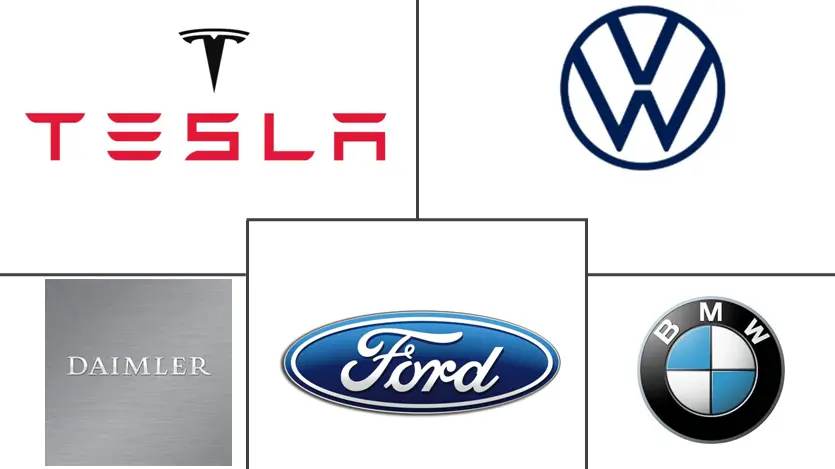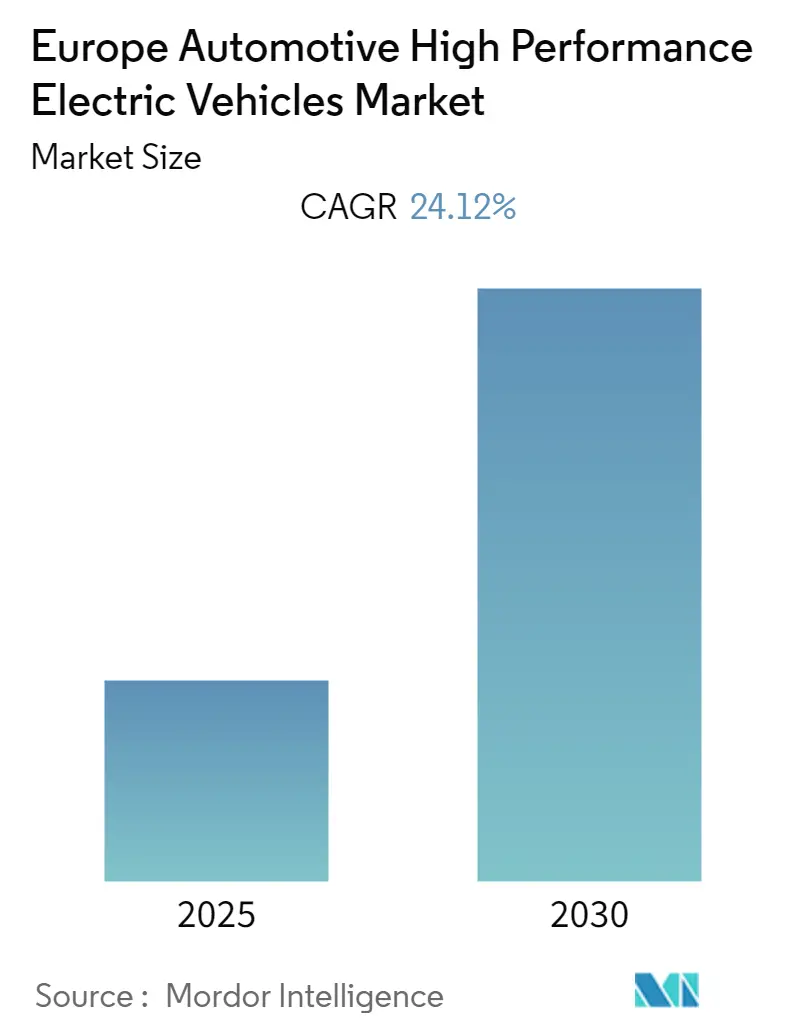
Europe Automotive High Performance Electric Vehicles Market Analysis by Mordor Intelligence
The Europe Automotive High Performance Electric Vehicles Market is expected to register a CAGR of 24.12% during the forecast period.
Over the long term, growing awareness of vehicle emissions, lower operating and maintenance costs, along increasing government initiatives to encourage the use of electric vehicles will drive the growth of high-performance electric vehicles. The growing demand for these types of vehicles is primarily due to the increasing popularity of racing events in Europe. An electric high-performance vehicle (EHPV) is propelled by electricity and is equipped with advanced electric vehicle powertrain components and Li-ion batteries with high energy density.
Europe set ambitious emission reduction targets to combat climate change. Tighter regulations, especially in urban areas, are aimed at reducing pollution and encouraging the introduction of electric vehicles (EVs). These regulations, such as low emission zones and stringent emission standards, are encouraging fleet managers to switch to electric commercial vehicles.
Governments across Europe offer various incentives to encourage the uptake of electric vehicles. These incentives include purchase subsidies, tax incentives, and subsidies for building charging infrastructure. It helps offset the high acquisition costs of electric vans, making them more economically attractive to fleet operators.
According to the ACEA, the new light commercial vehicle registrations in the EU fell by 14.4%, totaling 102,226 units as of October 2022. All the major EU markets posted declines last month, especially Germany (-16.6%), Italy (-7.3%), and France (-6.7%), while new van sales remained relatively stable in Spain (-0.5%).
Furthermore, in Europe, Germany includes an increasing number of electric car sales in the region, as well as an increase in charging stations, which will also play an important part in boosting the sale of High-Performance electric vehicles. In 2021, there were around 59,400 publicly accessible charge points for electric vehicles in Germany. Furthermore, technological progress and new developments in the high-performance electric car market may help the market's growth in Germany.
Europe Automotive High Performance Electric Vehicles Market Trends and Insights
Increasing Demand of Luxury Vehicles is Expected to Drive the Market
Currently, the IC engine segment leads the high-performing luxury car market. However, during the forecast period, the demand for IC engine vehicles is anticipated to slow down as major players in the European region are planning to completely stop the production of gasoline cars and focus on manufacturing electric cars only. For instance,
- In September 2023, Volvo Cars announced the end of production of all its diesel-powered models by early 2024. The company plans to sell only fully electric cars by 2030 and to be a climate-neutral company by 2040. Recently, the company also announced to exit of the development of new combustion engines.
It can be attributed to growing environmental concerns due to rising exhaust emissions. Governments in Europe and environmental associations are tightening emission norms. A 45% reduction in CO2 emissions by 2030 requires more than 400,000 zero-emission vehicles on the road. Therefore, various government initiatives and regulations will also boost the growth of high-performance electric luxury vehicles in the market.
As a result, the demand for sustainable and eco-friendly transportation, such as EVs, is increasing, with governments offering more incentives and subsidies to these vehicle owners.
Currently, major players, such as Mercedes-Benz, BMW, Audi, and Tesla, cover a significant percentage of the share in the EV segment of the luxury car market. Additionally, luxury car component manufacturers are also focusing on developing next-generation smart mobility technologies, such as autonomous driving, personal voice assistance, and retinal recognition. These are expected to boost the sales of luxury EVs over the forecast period.
Further, the growing number of HNWI in the European region is also expected to contribute to the growth of the electric luxury vehicle market. In Europe, the overall average financial wealth per adult as of 2022 was USD 84,308. In terms of private wealth, Europe held the second highest value in the world after North America.
Hence, the factors above are expected to contribute to the growth of the market during the forecast period.
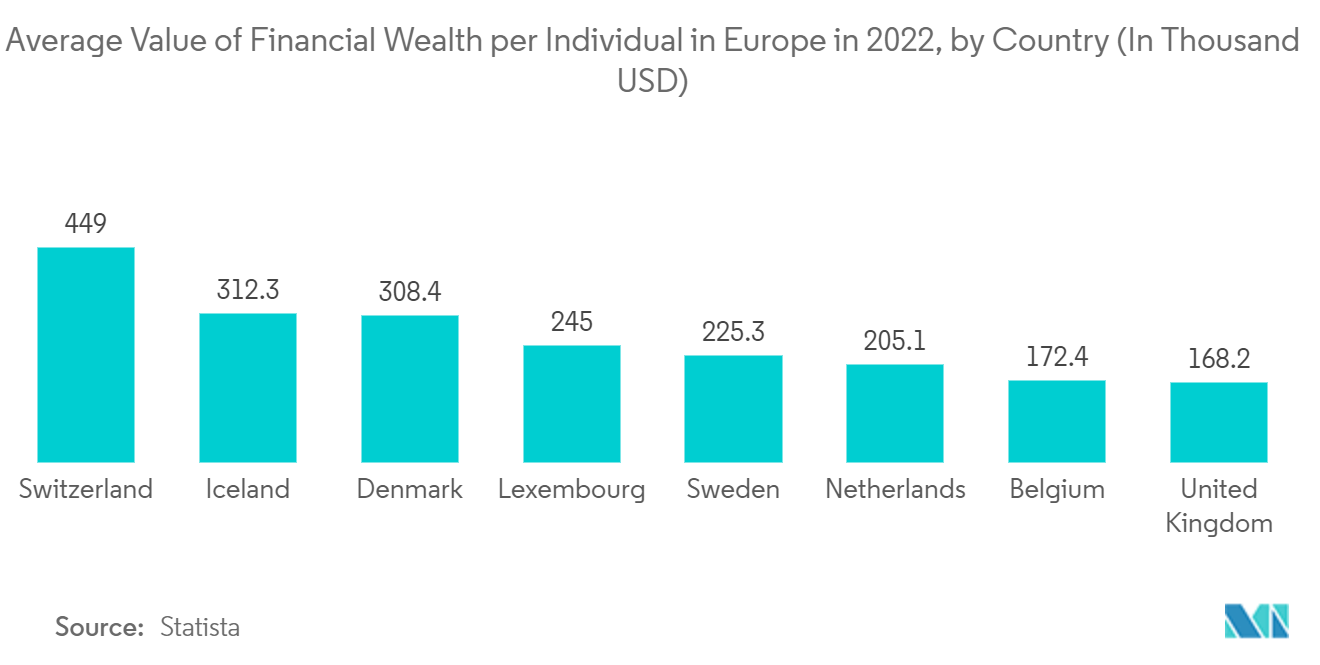
Germany is Leading the Market
Germany is leading the electric vehicle market in the region as, according to the Federal Motor Transport Authority, a quarter more electric cars were registered in Germany in the first half of 2022 than the previous year over the same period. During that time, the proportion of fully electric vehicles climbed to 13.5% of all new registrations. Overall, alternative-drive car registrations climbed by 14.2%, accounting for over half of all new car registrations (battery electric vehicles, hybrids, plug-in hybrids, hydrogen fuel cell vehicles, and gas vehicles). German brands accounted for 50.6% of new passenger car registrations with electric powertrains during the reporting period.
By 2030, Germany hopes to include 15 million electric vehicles on the road. Furthermore, the German Federal Government is aggressively supporting the usage of plug-in electric vehicles. Furthermore, since the rise in BEV subsidies in June 2020, the market share of BEVs steadily increased. Aside from the environmental benefits, the increasing availability of electric vehicles on the market is driving growth.
However, there is evidence of the country's growing popularity of electric automobiles. As a result, the German government is anticipated to eliminate financial incentives for acquiring electric vehicles next year, as rising popularity renders government subsidies outdated. E-vehicles are getting more popular and will soon no longer require government subsidies. According to the plan, subsidies for solely electric vehicles priced under EUR 40,000 (USD 40,488) will be cut to EUR 4,500 (USD 4794.82) from EUR 6,000 (USD 6393.09) at the beginning of next year and to EUR 3,000 (USD 3196.55) by 2023. According to government sources, the incentives granted to electric car owners will expire once the next two years' budget of EUR 3.4 billion (USD 3.44 billion) is expended.
Moreover, the government in Germany also took a few steps to grow EVs in the country. For instance,
- In October 2022, as part of its push toward net zero emissions, the German government approved a plan to spend EUR 6.3 billion (USD 6.1 billion) over three years to rapidly expand the number of charging stations for electric vehicles across the country. The plan calls for a 14-fold increase in the number of charging stations, from currently around 70,000 to 1 million by 2030.
Thus, growing charging infrastructure across Europe is expected to drive the automotive high-performance vehicle in the market.
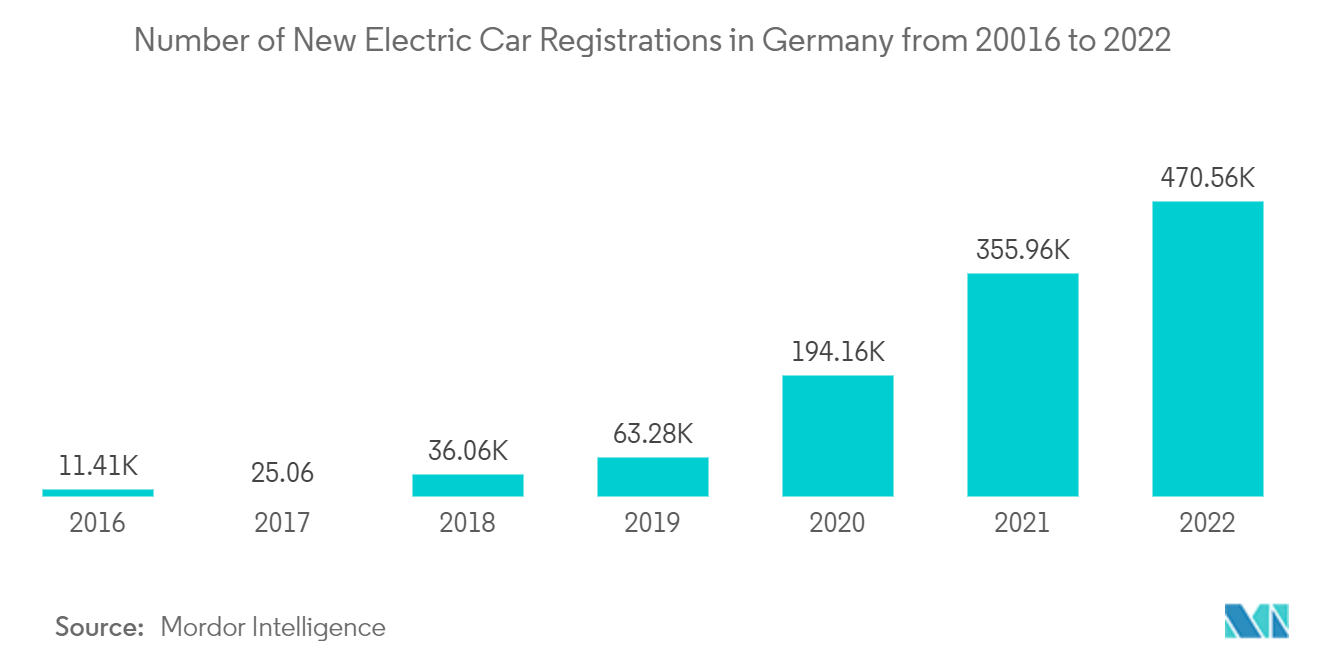
Competitive Landscape
The European automotive high-performance electric vehicles market is moderately consolidated and highly competitive with the presence of players such as BMW Group, Daimler AG, and Volkswagen AG, amongst others. Companies are launching new models and investing in R&D projects to provide the best technology to electric vehicle customers. Along with that, governments are also actively reforming their laws to increase the adoption of electric vehicles. For instance,
- In June 2023, as part of the Escalate Project, Electra Commercial Vehicles received funding from the European Horizon 2022 framework to develop a long-haul 40-tonne temperature-controlled drawbar battery electric vehicle. The truck will be built on an Electras eStar LEM27-350 chassis, with a drawbar trailer that includes energy-efficient electrically powered refrigerated systems, high-performance insulated box bodies with tail lifts, and the latest technology in lightweight, low-profile solar panels to help maximize range.
- In September 2022, Mercedes-Benz Trucks stated that real-world testing of its battery-electric heavy-duty long-distance vehicle will begin soon. Amazon and Rhenus plan to put the eActros LongHaul through its paces as early as 2023. Mercedes-Benz Trucks signed a letter of intent with both firms. The series will begin production in 2024.
Hence, the developments above are expected to drive the automotive high-performance electric vehicle market.
Europe Automotive High Performance Electric Vehicles Industry Leaders
Telsa Inc.
Volkswagen AG
Daimler AG
Ford Motor Company
BMW Group
- *Disclaimer: Major Players sorted in no particular order
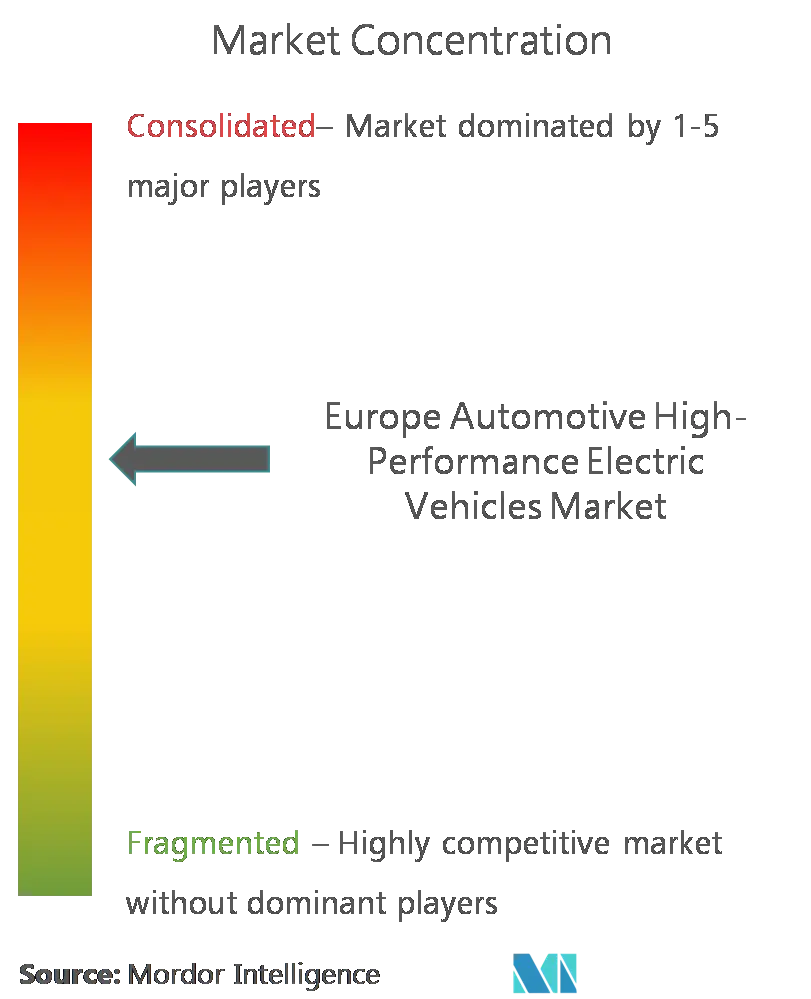
Recent Industry Developments
- June 2023: Mercedes-Benz revealed the AMG EQE 53 4MATIC+ SUV. Mercedes-AMG's latest model stands out as the most adaptable electric vehicle in their lineup, combining a customizable cabin with a performance-oriented drive concept.
- May 2023: Aston Martin announced a collaboration with Bowers & Wilkins as its audio partner to provide a new surround sound system in its vehicles. They will concentrate on creating an optional surround sound system upgrade, as well as technical innovation and great performance. Aston Martin will use a Bowers & Wilkins audio system in future vehicles in the coming years.
- August 2022: In anticipation of the IAA Transportation 2022, ZF Friedrichshafen AG (ZF) stated that its Commercial Vehicle Solutions (CVS) division had exhibited the most modern mobility innovations. The all-electric powertrain combines cutting-edge control technologies to reimagine the dynamic, elegant, and precise mix that marks BMW M automobiles as high-performance sports cars.
- July 2022: Ford presented the new F-150 Raptor R, which will be powered by a 5.2 l V8 engine producing 700 HP. Its launch is the consequence of consumer demand for a Raptor with a V8 engine. Ford's new F-150 Raptor R includes characteristics of previous versions with a performance increase.
Europe Automotive High Performance Electric Vehicles Market Report Scope
Automotive High-Performance Electric Vehicles differ from other electric vehicles in several ways, including a longer range (over 150 miles on a single charge), high acceleration, and the ability to reach speeds of more than 90 miles per hour with a faster acceleration of 0 to 60 miles per hour.
The European automotive high-performance electric vehicles market is segmented by drive type, vehicle type, and country. By drive type, the market is segmented into plug-in hybrid and battery or pure electric. By vehicle type, the market is segmented into passenger cars and commercial vehicles. By country, the market is segmented into Germany, the United Kingdom, Italy, France, Spain, and the rest of Europe.
The report offers the market size and forecasts in value (USD) for all the above segments.
| Plug-in Hybrid |
| Battery or Pure Electric |
| Passenger Cars |
| Commercial Vehicles |
| Germany |
| United Kingdom |
| Italy |
| France |
| Spain |
| Rest of Europe |
| By Drive Type | Plug-in Hybrid |
| Battery or Pure Electric | |
| By Vehicle Type | Passenger Cars |
| Commercial Vehicles | |
| By Country | Germany |
| United Kingdom | |
| Italy | |
| France | |
| Spain | |
| Rest of Europe |
Key Questions Answered in the Report
What is the current Europe Automotive High Performance Electric Vehicles Market size?
The Europe Automotive High Performance Electric Vehicles Market is projected to register a CAGR of 24.12% during the forecast period (2025-2030)
Who are the key players in Europe Automotive High Performance Electric Vehicles Market?
Telsa Inc., Volkswagen AG, Daimler AG, Ford Motor Company and BMW Group are the major companies operating in the Europe Automotive High Performance Electric Vehicles Market.
What years does this Europe Automotive High Performance Electric Vehicles Market cover?
The report covers the Europe Automotive High Performance Electric Vehicles Market historical market size for years: 2019, 2020, 2021, 2022, 2023 and 2024. The report also forecasts the Europe Automotive High Performance Electric Vehicles Market size for years: 2025, 2026, 2027, 2028, 2029 and 2030.
Page last updated on:
Europe Automotive High Performance Electric Vehicles Market Report
Statistics for the 2025 Europe Automotive High Performance Electric Vehicles market share, size and revenue growth rate, created by Mordor Intelligence™ Industry Reports. Europe Automotive High Performance Electric Vehicles analysis includes a market forecast outlook for 2025 to 2030 and historical overview. Get a sample of this industry analysis as a free report PDF download.
